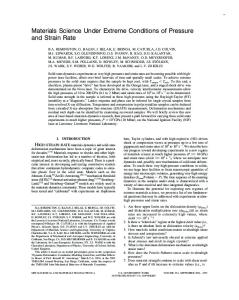Determination of stress and strain concentrations in the elastic-plastic materials under bending and torsion
- PDF / 2,475,954 Bytes
- 8 Pages / 595.276 x 793.701 pts Page_size
- 49 Downloads / 369 Views
DETERMINATION OF STRESS AND STRAIN CONCENTRATIONS IN THE ELASTIC-PLASTIC MATERIALS UNDER BENDING AND TORSION M. Kurek,1,2 T. Łagoda,1 and P. Warmuzek1 The analysis of stress and strain concentrations of constructional materials subjected to bending and torsion is presented. The known methods of stress determination for any elastic-plastic material assume the linear strain concentration under bending and torsion. The determination of stress and strain concentrations and their presentation as graphs were the main aims of this paper. Five materials were tested. They had different cyclic strain curves and were loaded by torsional and bending moments. The results proved the linear character of the strain distribution for any material in the entire applied loading range. Keywords: stress, strain, bending, torsion, cyclic loading.
The precise determination of the fatigue life requires the determination of the stress and strain distribution in the specimen section or in the element in the regions of elastic-plastic strains. Thus, we obtain the stresses on the surface and the distribution of stresses and strains used for nonlocal models, which more and more often occur at present [1, 3]. In the literature, the state of the art and the character of the elastic-plastic strain distribution under bending and torsion are not explained. The known methods of stress determination for elastic-plastic materials assume the linear strain distribution under bending and torsion [7, 8]. In [5], it was found that the presented models of determination of stresses and strains from known elastic stresses using the methods proposed by Neuber [10], Molski and Glinka [9], and Łagoda and Macha [6] give incorrect results for bending. The occurrence of stress and strain gradients causes serious difficulties in the determination of the fatigue life under bending, torsion, and combined bending and torsion [4]. The precise determination of the stress and strain distribution requires numerical calculations [e.g., the finite-element method (FEM)], and so approximate analytic equations are often used. According to [5], in the determination of local stresses and strains under bending, the normal stresses and strains occurring in both elastic and elastic-plastic models must compensate for a given bending moment, i.e.
Mg =
∫ σ(x, y)xdS .
(1)
S
Under torsion, like under bending, the basic relationship that must be satisfied says that the shear strain occurring in both elastic and elastic-plastic models must compensate for a given torsional model, i.e.,
Ms =
∫ τ(x, y)xdS .
(2)
S
1 2
Opole University of Technology, Opole, Poland. Corresponding author; e-mail: [email protected].
Published in Fizyko-Khimichna Mekhanika Materialiv, Vol. 47, No. 4, pp. 108–114, July–August, 2011. Original article submitted April 5, 2011. 1068-820X/12/4704–0545
© 2012
Springer Science+Business Media, Inc.
545
546
M. KUREK, T. ŁAGODA,
AND
P. WARMUZEK
Fig. 1. Isometric view of the FEM model of a cylindrical specimen. Table 1. Properties of Considered Mat
Data Loading...











